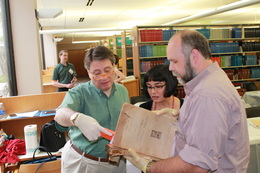
Did you know that dryer sheets can be used to salvage wet books? Yes, indeed. According to Ann Frellsen, American Institute for Conservation-Certified disaster response trainer, those used Bounce® sheets that we toss out on laundry day are absorbent enough to interleave between the pages of damp books. Ms. Frellsen spoke to over 20 professionals from archives, libraries, and museums on May 28 at a disaster recovery and salvage workshop. PALMCOP teamed up with the South Carolina Archival Association to sponsor this event in Florence, SC.
Bill McRee, Celeste Wiley, and Walter Hill examine items
for recovery in workshop at Francis Marion University.
Since it is a goal of PALMCOP to restore our education series, we are beginning with efforts to offer a disaster recovery workshop. A number of the attendees of the Florence event opted to become better educated in disaster response so that they may, in turn, prepare staff of other institutions.
Ms. Frellsen gave a morning lecture in which she emphasized disaster planning as crucial to a successful recovery. She described the elements of a good plan, gave a checklist of items needed in an institution’s recovery kit, and pointed out key things for a recovery team to know. Create your institution’s emergency plan first, and keep it current. Make sure to keep it in a safe place. Keep copies in multiple places and also make sure to save it electronically. When disaster does strike, safety is the first response! The recovery team should ensure that staff and visitors are out of danger. Once the evacuated building is cleared for re-entry, the team should assess the overall damage to the building and collections before beginning any salvage of collections. However, a quick response is necessary to save items from mold, which can be expected in to appear in about 48 hours. Other important lessons Frellsen imparted were to remain calm and mindful during the assessment process. Be alert to “helpers” who may take advantage of the situation and walk away with valuables. Wear protective gear at all times such as a breathing mask, gloves, a protective vest, and a hard hat. Additionally, she stated that reliable information can be found on the Internet. FEMA offers classes online to ordinary civilians on how to respond to various emergencies. You can sign up for these classes on the FEMA website.
For the second part of her presentation, Frellsen led a hand-on session inside FMU’s library in which recovery teams of five persons were formed from the 20 participants. Each team decided who would be team leader, made decisions on how items would be treated, sorted the items, and began the drying process. Not only did the team members handle books and similar print items, but also art work, clothing, electronics, even toys. Some items were puzzling, but during the wrap-up the teams shared how they interpreted items and how their decisions were made.
Participants left the workshop better educated in improving their institution’s disaster plan, and in training their staff in wet materials salvage. And from now on, they will save those Bounce® sheets!
-- Suzanne Singleton, PALMCOP Chair
| |

 RSS Feed
RSS Feed